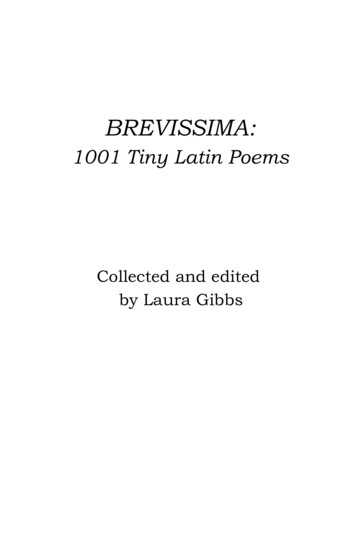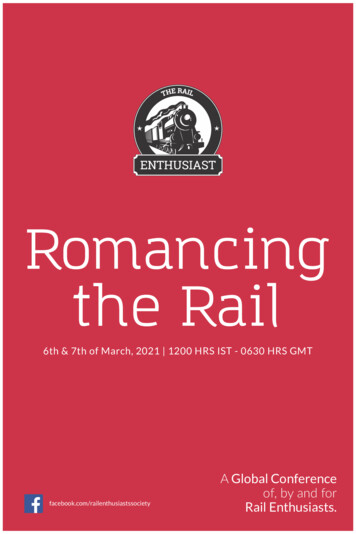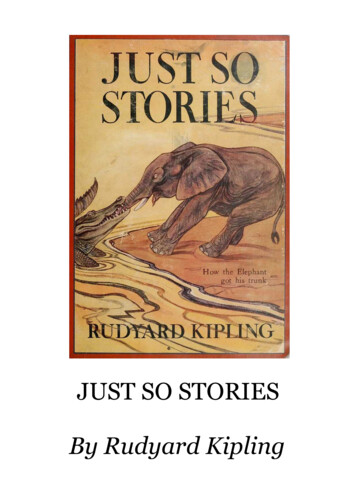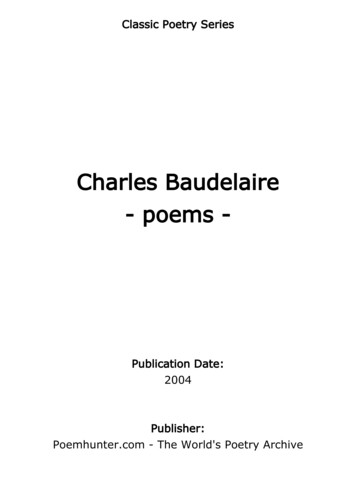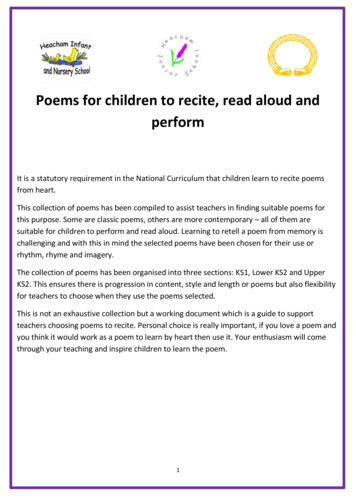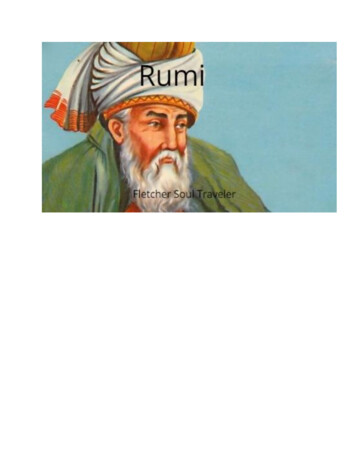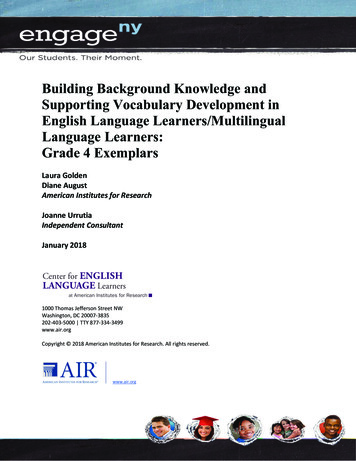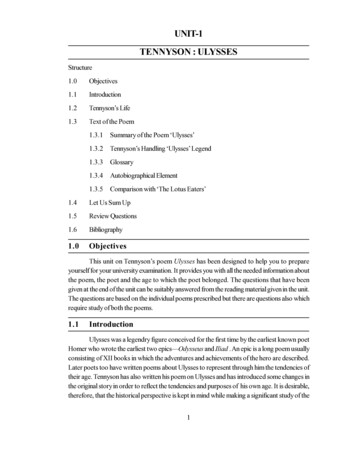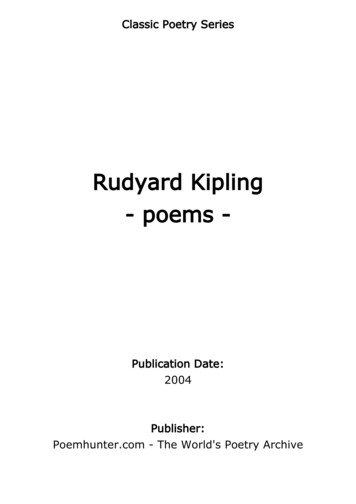
Transcription
Classic Poetry SeriesRudyard Kipling- poems -Publication Date:2004Publisher:Poemhunter.com - The World's Poetry Archive
Rudyard Kipling(30 December 1865 – 18 January1936)an English poet, short-story writer, and novelist chiefly remembered for hiscelebration of British imperialism, tales and poems of British soldiers in India,and his tales for children. Kipling received the 1907 Nobel Prize for Literature. Hewas born in Bombay, in the Bombay Presidency of British India, and was takenby his family to England when he was five years old. Kipling is best known for hisworks of fiction, including The Jungle Book (a collection of stories which includes"Rikki-Tikki-Tavi"), Just So Stories (1902) (1894), Kim (1901) (a tale ofadventure), many short stories, including "The Man Who Would Be King" (1888);and his poems, including Mandalay (1890), Gunga Din (1890), The White Man'sBurden (1899) and If— (1910). He is regarded as a major "innovator in the art ofthe short story"; his children's books are enduring classics of children's literature;and his best works are said to exhibit "a versatile and luminous narrative gift".Kipling was one of the most popular writers in England, in both prose and verse,in the late 19th and early 20th centuries. Henry James said: "Kipling strikes mepersonally as the most complete man of genius (as distinct from fine intelligence)that I have ever known." In 1907 he was awarded the Nobel Prize in Literature,making him the first English-language writer to receive the prize, and to date heremains its youngest recipient. Among other honours, he was sounded out forthe British Poet Laureateship and on several occasions for a knighthood, all ofwhich he declined.Kipling's subsequent reputation has changed according to the political and socialclimate of the age and the resulting contrasting views about him continued formuch of the 20th century. George Orwell called him a "prophet of Britishimperialism". Literary critic Douglas Kerr wrote: "He [Kipling] is still an authorwho can inspire passionate disagreement and his place in literary and culturalhistory is far from settled. But as the age of the European empires recedes, he isrecognised as an incomparable, if controversial, interpreter of how empire wasexperienced. That, and an increasing recognition of his extraordinary narrativegifts, make him a force to be reckoned with."Childhood and Early LifeRudyard Kipling was born on 30 December 1865 in Bombay, in British India toAlice Kipling (née MacDonald) and (John) Lockwood Kipling. Alice (one of fourremarkable Victorian sisters) was a vivacious woman about whom a futurewww.PoemHunter.com - The World's Poetry Archive1
Viceroy of India would say, "Dullness and Mrs. Kipling cannot exist in the sameroom." Lockwood Kipling, a sculptor and pottery designer, was the Principal andProfessor of Architectural Sculpture at the newly founded Sir JamsetjeeJeejeebhoy School of Art and Industry in Bombay.John and Alice had met in 1863 and courted at Rudyard Lake in Rudyard,Staffordshire, England. They married, and moved to India in 1865. They hadbeen so moved by the beauty of the Rudyard Lake area that when their first childwas born, they included a reference to the lake in naming him. Alice's sisterGeorgiana was married to painter Edward Burne-Jones, and her sister Agnes wasmarried to painter Edward Poynter. Kipling's most famous relative was his firstcousin, Stanley Baldwin, who was Conservative Prime Minister of the UK threetimes in the 1920s and 1930s. Kipling's birth home still stands on the campus ofthe J J School of Art in Mumbai and for many years was used as the Dean'sresidence. Mumbai historian Foy Nissen points out, however, that although thecottage bears a plaque stating that this is the site where Kipling was born, theoriginal cottage was torn down decades ago and a new one was built in its place.The wooden bungalow has been empty and locked up for years.Of Bombay, Kipling was to write:Mother of Cities to me,For I was born in her gate,Between the palms and the sea,Where the world-end steamers wait.According to Bernice M. Murphy, "Kipling’s parents considered themselves 'AngloIndians' (a term used in the 19th century for people of British origin living inIndia) and so too would their son, though he spent the bulk of his life elsewhere.Complex issues of identity and national allegiance would become prominentfeatures in his fiction." Kipling referred to such conflicts; for example: "In theafternoon heats before we took our sleep, she (the Portuguese ayah, or nanny)or Meeta (the Hindu bearer, or male attendant) would tell us stories and Indiannursery songs all unforgotten, and we were sent into the dining-room after wehad been dressed, with the caution 'Speak English now to Papa and Mamma.' Soone spoke 'English', haltingly translated out of the vernacular idiom that onethought and dreamed in".Kipling's days of "strong light and darkness" in Bombay ended when he was fivewww.PoemHunter.com - The World's Poetry Archive2
years old. As was the custom in British India, he and his three-year-old sister,Alice ("Trix"), were taken to England—in their case to Southsea (Portsmouth), tolive with a couple who boarded children of British nationals who were serving inIndia. The two children lived with the couple, Captain and Mrs. Holloway, at theirhouse, Lorne Lodge, for the next six years. In his autobiography, published some65 years later, Kipling recalled the stay with horror, and wondered ironically ifthe combination of cruelty and neglect which he experienced there at the handsof Mrs. Holloway might not have hastened the onset of his literary life: "If youcross-examine a child of seven or eight on his day’s doings (specially when hewants to go to sleep) he will contradict himself very satisfactorily. If eachcontradiction be set down as a lie and retailed at breakfast, life is not easy. Ihave known a certain amount of bullying, but this was calculated torture —religious as well as scientific. Yet it made me give attention to the lies I soonfound it necessary to tell: and this, I presume, is the foundation of literaryeffort".Trix fared better at Lorne Lodge; Mrs. Holloway apparently hoped that Trix wouldeventually marry the Holloway son. The two Kipling children, however, did haverelatives in England whom they could visit. They spent a month each Christmaswith their maternal aunt Georgiana ("Georgy"), and her husband at their house,"The Grange" in Fulham, London, which Kipling was to call "a paradise which Iverily believe saved me." In the spring of 1877, Alice returned from India andremoved the children from Lorne Lodge. Kipling remembers, "Often and oftenafterwards, the beloved Aunt would ask me why I had never told any one how Iwas being treated. Children tell little more than animals, for what comes to themthey accept as eternally established. Also, badly-treated children have a clearnotion of what they are likely to get if they betray the secrets of a prison-housebefore they are clear of it".In January 1878 Kipling was admitted to the United Services College, atWestward Ho!, Devon, a school founded a few years earlier to prepare boys forthe British Army. The school proved rough going for him at first, but later led tofirm friendships, and provided the setting for his schoolboy stories Stalky & Co.(1899). During his time there, Kipling also met and fell in love with FlorenceGarrard, who was boarding with Trix at Southsea (to which Trix had returned).Florence was to become the model for Maisie in Kipling's first novel, The Lightthat Failed (1891).Near the end of his stay at the school, it was decided that he lacked theacademic ability to get into Oxford University on a scholarship and his parentslacked the wherewithal to finance him, so Lockwood obtained a job for his son inLahore, Punjab (now in Pakistan), where Lockwood was now Principal of thewww.PoemHunter.com - The World's Poetry Archive3
Mayo College of Art and Curator of the Lahore Museum. Kipling was to beassistant editor of a small local newspaper, the Civil & Military Gazette.He sailed for India on 20 September 1882 and arrived in Bombay on 18 October.He described this moment years later: "So, at sixteen years and nine months,but looking four or five years older, and adorned with real whiskers which thescandalised Mother abolished within one hour of beholding, I found myself atBombay where I was born, moving among sights and smells that made medeliver in the vernacular sentences whose meaning I knew not. Other Indianborn boys have told me how the same thing happened to them." This arrivalchanged Kipling, as he explains, "There were yet three or four days’ rail toLahore, where my people lived. After these, my English years fell away, nor ever,I think, came back in full strength".Early TravelsThe Civil and Military Gazette in Lahore, the newspaper which Kipling was to call"mistress and most true love," appeared six days a week throughout the yearexcept for a one-day break each for Christmas and Easter. Kipling was workedhard by editor Stephen Wheeler, but Kipling's need to write was unstoppable. In1886 he published his first collection of verse, Departmental Ditties. That yearalso brought a change of editors at the newspaper; Kay Robinson, the neweditor, allowed more creative freedom and Kipling was asked to contribute shortstories to the newspaper.During the summer of 1883, Kipling visited Shimla (then known as Simla), awell-known hill station and summer capital of British India. By then it wasestablished practice for the Viceroy of India and the government to move toSimla for six months and the town became a "centre of power as well aspleasure." Kipling's family became yearly visitors to Simla and Lockwood Kiplingwas asked to serve in the Christ Church there. Rudyard Kipling returned to Simlafor his annual leave each year from 1885 to 1888, and the town figuredprominently in many of the stories that he wrote for the Gazette. He describesthis time: "My month’s leave at Simla, or whatever Hill Station my people wentto, was pure joy—every golden hour counted. It began in heat and discomfort, byrail and road. It ended in the cool evening, with a wood fire in one’s bedroom,and next morn—thirty more of them ahead!—the early cup of tea, the Motherwho brought it in, and the long talks of us all together again. One had leisure towork, too, at whatever play-work was in one’s head, and that was usually full."Back in Lahore, some thirty-nine stories appeared in the Gazette betweenNovember 1886 and June 1887. Most of these stories were included in Plain Talesfrom the Hills, Kipling's first prose collection, which was published in Calcutta inwww.PoemHunter.com - The World's Poetry Archive4
January 1888, a month after his 22nd birthday. Kipling's time in Lahore,however, had come to an end. In November 1887 he was transferred to theGazette's much larger sister newspaper, The Pioneer, in Allahabad in the UnitedProvinces.Kipling's writing continued at a frenetic pace; in 1888 he published six collectionsof short stories: Soldiers Three, The Story of the Gadsbys, In Black and White,Under the Deodars, The Phantom Rickshaw, and Wee Willie Winkie, containing atotal of 41 stories, some quite long. In addition, as The Pioneer's specialcorrespondent in western region of Rajputana, he wrote many sketches that werelater collected in Letters of Marque and published in From Sea to Sea and OtherSketches, Letters of Travel.Kipling was discharged from The Pioneer in early 1889, after a dispute. By thistime he had been increasingly thinking about the future. He sold the rights to hissix volumes of stories for 200 and a small royalty, and the Plain Tales for 50;in addition, from The Pioneer, he received six-months' salary in lieu of notice. Hedecided to use this money to make his way to London, the centre of the literaryuniverse in the British Empire. On 9 March 1889, Kipling left India, travelling firstto San Francisco via Rangoon, Singapore, Hong Kong and Japan. He thentravelled through the United States, writing articles for The Pioneer that werelater published in From Sea to Sea and Other Sketches, Letters of Travel.Starting his American travels in San Francisco, Kipling journeyed north toPortland, Oregon; to Seattle, Washington; up into Canada, to Victoria andVancouver, British Columbia; back into the U.S. to Yellowstone National Park;down to Salt Lake City; then east to Omaha, Nebraska, and on to Chicago,Illinois; then to Beaver, Pennsylvania on the Ohio River to visit the Hill family;from there he went to Chautauqua with Professor Hill, and later to Niagara Falls,Toronto, Washington, D.C., New York and Boston. In the course of this journeyhe met Mark Twain in Elmira, New York, and was deeply impressed. He thencrossed the Atlantic, and reached Liverpool in October 1889. He soon made hisdébut in the London literary world to great acclaim.Career as A WriterLondonIn London Kipling had several stories accepted by various magazine editors. Healso found a place to live for the next two years:Meantime, I had found me quarters in Villiers Street, Strand, which forty-sixyears ago was primitive and passionate in its habits and population. My roomswww.PoemHunter.com - The World's Poetry Archive5
were small, not over-clean or well-kept, but from my desk I could look out of mywindow through the fanlight of Gatti’s Music-Hall entrance, across the street,almost on to its stage. The Charing Cross trains rumbled through my dreams onone side, the boom of the Strand on the other, while, before my windows, FatherThames under the Shot Tower walked up and down with his traffic.In the next two years he published a novel, The Light that Failed, had a nervousbreakdown, and met an American writer and publishing agent, Wolcott Balestier,with whom he collaborated on a novel, The Naulahka (a title which heuncharacteristically misspelt; see below). In 1891, on the advice of his doctors,Kipling embarked on another sea voyage visiting South Africa, Australia, NewZealand and once again India. However, he cut short his plans for spendingChristmas with his family in India when he heard of Balestier's sudden deathfrom typhoid fever, and immediately decided to return to London. Before hisreturn, he had used the telegram to propose to and be accepted by Wolcott'ssister Caroline Starr Balestier (1862–1939), called “Carrie”, whom he had met ayear earlier, and with whom he had apparently been having an intermittentromance. Meanwhile, late in 1891, his collection of short stories of the British inIndia, Life's Handicap, was published in London.On 18 January 1892, Carrie Balestier (aged 29) and Rudyard Kipling (aged 26)were married in London, in the "thick of an influenza epidemic, when theundertakers had run out of black horses and the dead had to be content withbrown ones." The wedding was held at All Souls Church, Langham Place. HenryJames gave the bride away.United StatesThe couple settled upon a honeymoon that would take them first to the UnitedStates (including a stop at the Balestier family estate near Brattleboro, Vermont)and then on to Japan. However, when they arrived in Yokohama, Japan, theydiscovered that their bank, The New Oriental Banking Corporation, had failed.Taking this loss in their stride, they returned to the U.S., back toVermont—Carrie by this time was pregnant with their first child—and rented asmall cottage on a farm near Brattleboro for ten dollars a month. According toKipling, "We furnished it with a simplicity that fore-ran the hire-purchase system.We bought, second or third hand, a huge, hot-air stove which we installed in thecellar. We cut generous holes in our thin floors for its eight-inch [20 cm] tin pipes(why we were not burned in our beds each week of the winter I never canunderstand) and we were extraordinarily and self-centredly content."In this house, which they called Bliss Cottage, their first child, Josephine, waswww.PoemHunter.com - The World's Poetry Archive6
born "in three foot of snow on the night of 29 December 1892. Her Mother’sbirthday being the 31st and mine the 30th of the same month, we congratulatedher on her sense of the fitness of things ."It was also in this cottage that the first dawnings of the Jungle Books came toKipling: " . . workroom in the Bliss Cottage was seven feet by eight, and fromDecember to April the snow lay level with its window-sill. It chanced that I hadwritten a tale about Indian Forestry work which included a boy who had beenbrought up by wolves. In the stillness, and suspense, of the winter of ’92 somememory of the Masonic Lions of my childhood’s magazine, and a phrase inHaggard’s Nada the Lily, combined with the echo of this tale. After blocking outthe main idea in my head, the pen took charge, and I watched it begin to writestories about Mowgli and animals, which later grew into the two Jungle Books ".With Josephine's arrival, Bliss Cottage was felt to be congested, so eventually thecouple bought land—10 acres (40,000 m2) on a rocky hillside overlooking theConnecticut River—from Carrie's brother Beatty Balestier, and built their ownhouse.Kipling named the house "Naulakha" in honour of Wolcott and of theircollaboration, and this time the name was spelled correctly. From his early yearsin Lahore (1882–87), Kipling had become enthused by the Mughal architecture,especially the Naulakha pavilion situated in Lahore Fort, which eventually becamean inspiration for the title of his novel as well as the house. The house still standson Kipling Road, three miles (5 km) north of Brattleboro in Dummerston,Vermont: a big, secluded, dark-green house, with shingled roof and sides, whichKipling called his "ship", and which brought him "sunshine and a mind at ease."His seclusion in Vermont, combined with his healthy "sane clean life", madeKipling both inventive and prolific.In the short span of four years, he produced, in addition to the Jungle Books, acollection of short stories (The Day's Work), a novel (Captains Courageous), anda profusion of poetry, including the volume The Seven Seas. The collection ofBarrack-Room Ballads, first published individually for the most part in 1890,which contains his poems "Mandalay" and "Gunga Din" was issued in March1892. He especially enjoyed writing the Jungle Books—both masterpieces ofimaginative writing—and enjoyed, too, corresponding with the many childrenwho wrote to him about them.The writing life in Naulakha was occasionally interrupted by visitors, including hisfather, who visited soon after his retirement in 1893, and British author ArthurConan Doyle, who brought his golf-clubs, stayed for two days, and gave Kiplingan extended golf lesson. Kipling seemed to take to golf, occasionally practisingwww.PoemHunter.com - The World's Poetry Archive7
with the local Congregational minister, and even playing with red-painted ballswhen the ground was covered in snow. However, wintertime golf was "notaltogether a success because there were no limits to a drive; the ball might skidtwo miles (3 km) down the long slope to Connecticut river."From all accounts, Kipling loved the outdoors, not least of whose marvels inVermont was the turning of the leaves each fall. He described this moment in aletter: "A little maple began it, flaming blood-red of a sudden where he stoodagainst the dark green of a pine-belt. Next morning there was an answeringsignal from the swamp where the sumacs grow. Three days later, the hill-sidesas fast as the eye could range were afire, and the roads paved, with crimson andgold. Then a wet wind blew, and ruined all the uniforms of that gorgeous army;and the oaks, who had held themselves in reserve, buckled on their dull andbronzed cuirasses and stood it out stiffly to the last blown leaf, till nothingremained but pencil-shadings of bare boughs, and one could see into the mostprivate heart of the woods."In February 1896 Elsie Kipling, the couple's second daughter, was born. By thistime, according to several biographers, their marital relationship was no longerlight-hearted and spontaneous. Although they would always remain loyal to eachother, they seemed now to have fallen into set roles. In a letter to a friend whohad become engaged around this time, the 30 year old Kipling offered thissombre counsel: marriage principally taught "the tougher virtues—such ashumility, restraint, order, and forethought."The Kiplings loved life in Vermont and might have lived out their lives there, wereit not for two incidents—one of global politics, the other of family discord—thathastily ended their time there. By the early 1890s the United Kingdom andVenezuela were in a border dispute involving British Guiana. The U.S. had madeseveral offers to arbitrate, but in 1895 the new American Secretary of StateRichard Olney upped the ante by arguing for the American "right" to arbitrate ongrounds of sovereignty on the continent (see the Olney interpretation as anextension of the Monroe Doctrine). This raised hackles in the UK and thesituation grew into a major Anglo-American crisis, with talk of war on both sides.Although the crisis led to greater U.S.-British cooperation, at the time Kipling wasbewildered by what he felt was persistent anti-British sentiment in the U.S.,especially in the press. He wrote in a letter that it felt like being "aimed at with adecanter across a friendly dinner table." By January 1896 he had decided to endhis family's "good wholesome life" in the U.S. and seek their fortunes elsewhere.A family dispute became the final straw. For some time, relations between Carriewww.PoemHunter.com - The World's Poetry Archive8
and her brother Beatty Balestier had been strained owing to his drinking andinsolvency. In May 1896 an inebriated Beatty encountered Kipling on the streetand threatened him with physical harm. The incident led to Beatty's eventualarrest, but in the subsequent hearing, and the resulting publicity, Kipling'sprivacy was destroyed, and he was left feeling miserable and exhausted. In July1896, a week before the hearing was to resume, the Kiplings hurriedly packedtheir belongings and left the United States.DevonBy September 1896 the Kiplings were in Torquay on the coast of Devon, in ahillside home overlooking the sea. Although Kipling did not much care for his newhouse, whose design, he claimed, left its occupants feeling dispirited and gloomy,he managed to remain productive and socially active. Kipling was now a famousman, and in the previous two or three years, had increasingly been makingpolitical pronouncements in his writings. The Kiplings had welcomed their firstson, John, in August 1896. Kipling had begun work on two poems, "Recessional"(1897) and "The White Man's Burden" (1899) which were to create controversywhen published. Regarded by some as anthems for enlightened and duty-boundempire-building (that captured the mood of the Victorian age), the poems equallywere regarded by others as propaganda for brazenfaced imperialism and itsattendant racial attitudes; still others saw irony in the poems and warnings of theperils of empire.Take up the White Man's burden—Send forth the best ye breed—Go, bind your sons to exileTo serve your captives' need;To wait, in heavy harness,On fluttered folk and wild—Your new-caught sullen peoples,Half devil and half child.—The White Man's Burdenwww.PoemHunter.com - The World's Poetry Archive9
There was also foreboding in the poems, a sense that all could yet come tonaught.Far-called, our navies melt away;On dune and headland sinks the fire:Lo, all our pomp of yesterdayIs one with Nineveh and Tyre!Judge of the Nations, spare us yet.Lest we forget – lest we forget!—RecessionalA prolific writer during his time in Torquay, he also wrote Stalky & Co., acollection of school stories (born of his experience at the United Services Collegein Westward Ho!) whose juvenile protagonists displayed a know-it-all, cynicaloutlook on patriotism and authority. According to his family, Kipling enjoyedreading aloud stories from Stalky & Co. to them, and often went into spasms oflaughter over his own jokes.South AfricaIn early 1898 the Kiplings travelled to South Africa for their winter holiday, thusbeginning an annual tradition which (excepting the following year) was to lastuntil 1908. They always stayed in "The Woolsack", a house on Cecil Rhodes'estate at Groote Schuur; it was within walking distance of Rhodes' mansion. Withhis new reputation as Poet of the Empire, Kipling was warmly received by someof the most influential politicians of the Cape Colony, including Rhodes, Sir AlfredMilner, and Leander Starr Jameson. Kipling cultivated their friendship and cameto admire the men and their politics. The period 1898–1910 was crucial in thehistory of South Africa and included the Second Boer War (1899–1902), theensuing peace treaty, and the 1910 formation of the Union of South Africa. Backin England, Kipling wrote poetry in support of the British cause in the Boer Warand on his next visit to South Africa in early 1900, he helped start a newspaper,The Friend, for Lord Roberts for the British troops in Bloemfontein, the newlycaptured capital of the Orange Free State. Although his journalistic stint was tolast only two weeks, it was Kipling's first work on a newspaper staff since he leftThe Pioneer in Allahabad more than ten years earlier. At The Friend he madewww.PoemHunter.com - The World's Poetry Archive10
lifelong friendships with Perceval Landon, H. A. Gwynne and others. He alsowrote articles published more widely expressing his views on the conflict. Kiplingpenned an inscription for the Honoured Dead Memorial (Siege memorial) inKimberley.SussexIn 1897, Kipling moved from Torquay to Rottingdean, East Sussex; first to NorthEnd House and later to The Elms. In 1902 Kipling bought Batemans, a housebuilt in 1634 and located in rural Burwash, East Sussex, England. The house,along with the surrounding buildings, the mill and 33 acres (130,000 m2) waspurchased for 9,300. It had no bathroom, no running water upstairs and noelectricity, but Kipling loved it: "Behold us, lawful owners of a grey stonelichened house—A.D. 1634 over the door—beamed, panelled, with old oakstaircase, and all untouched and unfaked. It is a good and peaceable place. Wehave loved it ever since our first sight of it." (from a November 1902 letter).Other WritingKipling began collecting material for another of his children's classics, Just SoStories for Little Children. That work was published in 1902, the year after Kimwas first issued.On a visit to the United States in 1899, Kipling and Josephine developedpneumonia, from which she eventually died. During the First World War, hewrote a booklet The Fringes of the Fleet containing essays and poems on variousnautical subjects of the war. Some of the poems were set to music by Englishcomposer Edward Elgar.Kipling wrote two science fiction short stories, With the Night Mail (1905) and AsEasy As A. B. C (1912), both set in the 21st century in Kipling's Aerial Board ofControl universe. These read like modern hard science fiction.In 1934 he published a short story in Strand Magazine, "Proofs of Holy Writ",which postulated that William Shakespeare had helped to polish the prose of theKing James Bible. In the non-fiction realm he also became involved in the debateover the British response to the rise in German naval power, publishing a seriesof articles in 1898 which were collected as A Fleet in Being.Peak of his careerThe first decade of the 20th century saw Kipling at the height of his popularity. Inwww.PoemHunter.com - The World's Poetry Archive11
1906 he wrote the song "Land of our Birth, We Pledge to Thee". In 1907 he wasawarded the Nobel Prize for Literature. The prize citation said: "In considerationof the power of observation, originality of imagination, virility of ideas andremarkable talent for narration which characterise the creations of this worldfamous author." Nobel prizes had been established in 1901 and Kipling was thefirst English-language recipient. At the award ceremony in Stockholm on 10December 1907, the Permanent Secretary of the Swedish Academy, Carl David afWirsén, praised both Kipling and three centuries of English literature:The Swedish Academy, in awarding the Nobel Prize in Literature this year toRudyard Kipling, desires to pay a tribute of homage to the literature of England,so rich in manifold glories, and to the greatest genius in the realm of narrativethat that country has produced in our times."Book-ending" this achievement was the publication of two connected poetry andstory collections: Puck of Pook's Hill (1906), and Rewards and Fairies (1910). Thelatter contained the poem "If—". In a 1995 BBC opinion poll, it was voted theUK's favourite poem. This exhortation to self-control and stoicism is arguablyKipling's most famous poem.Kipling sympathised with the anti-Home Rule stance of Irish Unionists. He wasfriends with Edward Carson, the Dublin-born leader of Ulster Unionism, whoraised the Ulster Volunteers to oppose "Home Rule" in Ireland. Kipling wrote thepoem "Ulster" in 1912 reflecting this. Kipling was a staunch opponent ofBolshevism, a position which he shared with his friend Henry Rider Haggard. Thetwo had bonded upon Kipling's arrival in London in 1889 largely on the strengthof their shared opinions, and they remained lifelong friends.Many have wondered why he was never made Poet Laureate. Some claim that hewas offered the post during the interregnum of 1892–96 and turned it down.At the beginning of World War I, like many other writers, Kipling wrotepamphlets which enthusiastically supported the UK's war aims.FreemasonryAccording to the English magazine Masonic Illustrated, Kipling became aFreemason in about 1885, prior to the usual minimum age of 21. He was initiatedinto Hope and Perseverance Lodge No. 782 in Lahore. He later wrote to TheTimes, "I was Secretary for some years of the Lodge . . . , which inclu
Lahore, where my people lived. After these, my English years fell away, nor ever, I think, came back in full strength". Early Travels The Civil and Military Gazette in Lahore, the newspaper which Kipling was to call "mistress and most true love," appeared six days a week throughout the year
